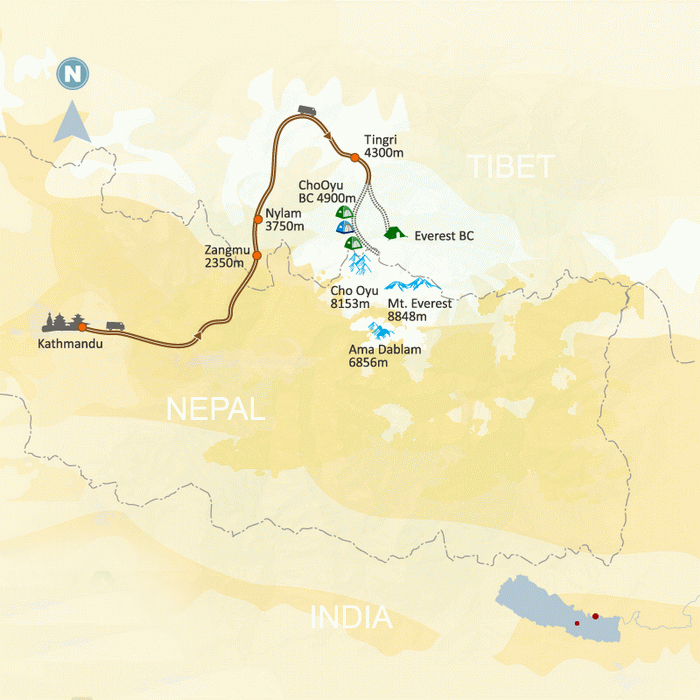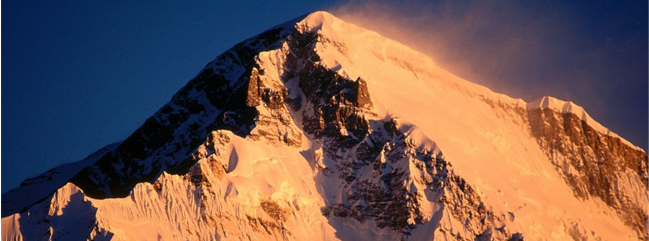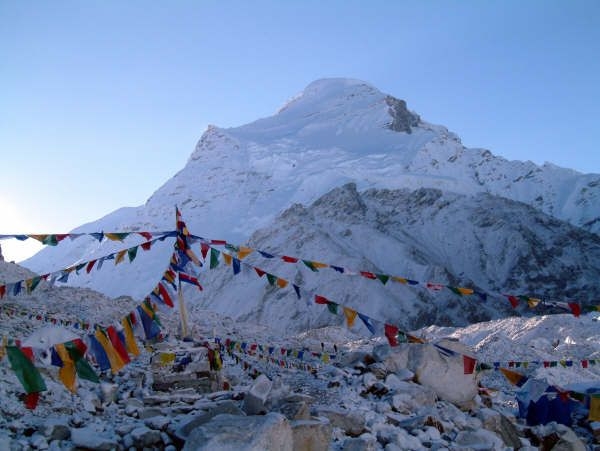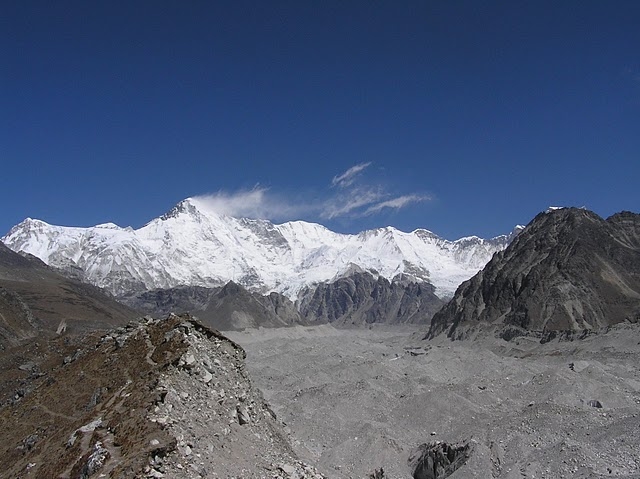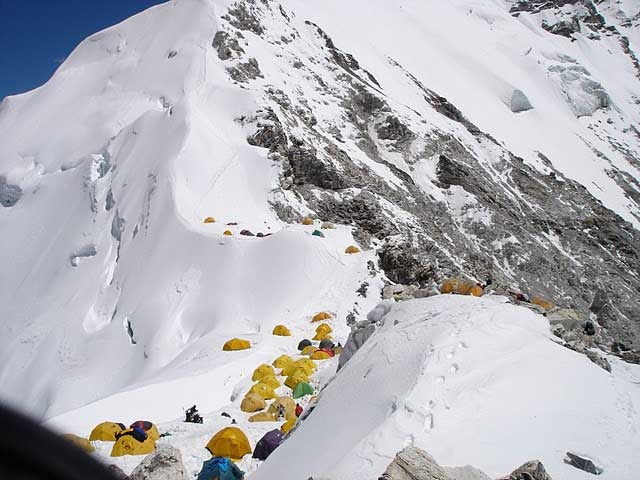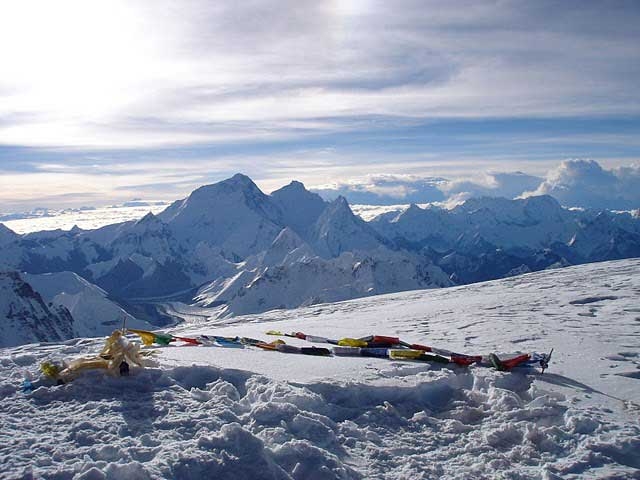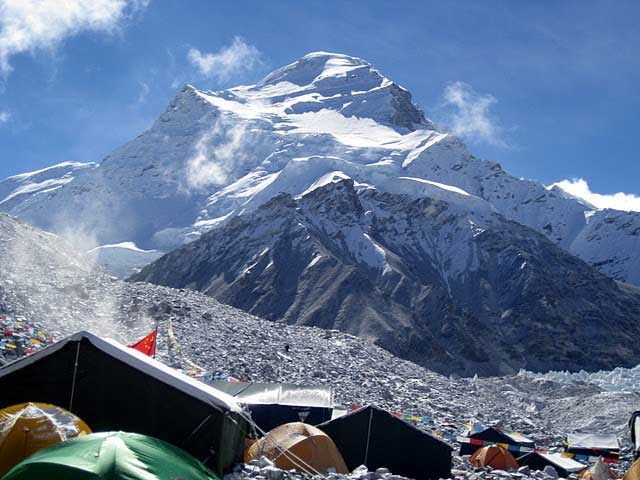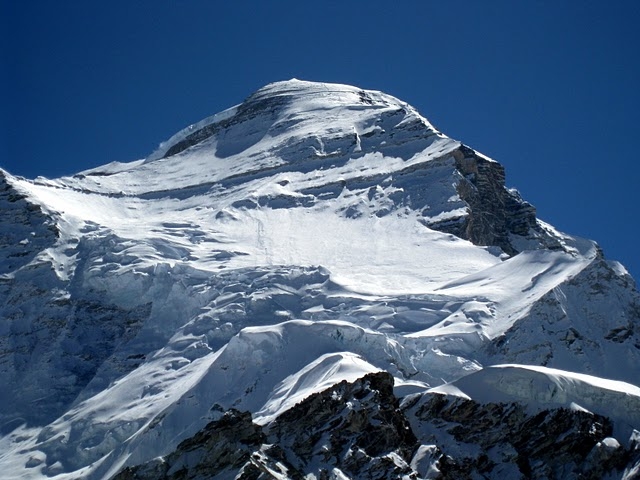The sixth highest peak of the world (8201m/26906ft) Cho Oyu stands for’ Turquoise God’ which means the turquoise color of the peak in the afternoon sun from the Tibet side of the mountain. But in Nepal it is known as Qowowuyag by the Sherpas. The mountain lies in the Himalayas and is 20 km west of Mount Everest, at the border between China and Nepal. Though the expedition attempt was made by Eric Shipton in1952, an Austrian Herbert Tichy made the first successful ascent of Cho Oyu in 1954 with fellow Austrians Sepp Jochler and Helmut Heuberger.
Our sensitively designed ‘Ace Cho Oyu Expedition’ offers you an excellent opportunity for the climbers to extend their experience to extreme altitudes and is highly recommended as a first 8,000m Peak. Climbing Cho Oyu is one of the best practices for attempting the Everest. This is also one of the best attainable of the among world’s highest mountains due to the lack of objective dangers in comparison to the other mountains. The terrain for this is uncomplicated, which makes the climbing assessable.
This trip starts from Kathmandu and ends in Kathmandu. It will be guided by our fully experienced Sherpa climbing guide. The indigenous Shepras were born in the Himalayas, reared in the Himalayas and involved in climbing and mountaineering occupation.
To begin this trip we fly from Kathmandu to Lhasa and spend a few days exploring the ancient Tibetan capital, taking time to let our bodies acclimatize, before driving across the Tibetan Plateau to Chinese Base Camp. This is the place from where we load up Yaks and trek to Cho Oyu base camp, below the north-west face. The route above base camp consists mainly of low-angled snow slopes up to 30° with one short but very steep section to bypass a sérac barrier at 6,400meters. We use three camps on the mountain; the highest at 7,500m is the launch pad for the summit, which is reached in 5 to 8 hours under normal conditions.
Day 01- Arrival in Kathmandu airport (1345meters).
There you will be met by our Airport Representative and transferred to hotel by private tourist vehicle. Overnight at hotel.
Day 02 – Pre-Trip meeting and Sightseeing in Kathmandu. Overnight at hotel.
After breakfast at 9 AM, we host a Pre-Trip meeting at your hotel and introduce your tour Guide(s) mean time and it will provide an opportunity for individuals to ask questions about the your tour and to introduce you to other participants. This includes a final briefing and preparations for the trip.
PLEASE ADVISE US IF YOU WILL BE ARRIVING LATE AND ARE THEREFORE UNABLE TO ATTEND THE PRE-TRIP MEETING.
IN THE PRE-TRIP MEETING All passengers MUST bring:
1. Passport.
2. Four copies of Passport size photos each.
3. Travel Insurance Policy.
4. A writing pen
5. Notepad.
After the Pre-Trip meeting and breakfast your sightseeing trip will start at 9.45 AM in the morning for both days. We provide a private vehicle and professional tour guide. The places we visit are as below:
Pashupatinath
Situated 5 kilometers east of Kathmandu city, Pashupatinath temple is considered one of the holiest Hindu temples dedicated to Lord Shiva. Situated amidst a lush green natural setting on the banks of the Bagmati River, the temple built in pagoda style has gilted roof and richly carved silver doors. Visitors are permitted to view the temple from the east bank of river Bagmati as entrance into the temple is strictly prohibited to all non Hindus. Pashupatinath is the center of annual pilgrimage on the day of the Shivaratri festival which happens around February/March. Behind the temple are the cremation grounds.
Boudhanath
This Stupa situated about 8 kms from Kathmandu City is one of the biggest of its kind in the world. Standing with a pair of eyes in each of the four directions, it symbolizes watchfulness. It is said that this Buddhist Stupa was built by King Man Deva at the advice of the goddess Mani Jogini. It rises from an octagonal base inset with prayer wheels. The shrine is surrounded by houses of Lamas or Buddhist priests. The Stupa is surrounded by a lot of monasteries.
Bhaktapur Durbar Square
As you walk in, you will feel a sense of inner harmony. Bhaktapur Durbar Square is a collection of pagoda and shikhara – style temples grouped around a fifty-five-window palace of brick and wood. The attraction of the Bhaktapur Durbar Square is The Lion gate, The Golden gate, The Palace of fifty-five windows, Art Galleries, The Statue of King Bhupatindra Malla.
Day 03- Official formalities in Kathmandu.
Formal briefing in the Ministry of Tourism. Today, the expedition leader will also check everyone’s equipment. Overnight at hotel.
Day 04- Final Preparation day in Kathmandu. Overnight at hotel.
The last opportunity to buy anything missing.
Day 05- Fly to Lhasa. Overnight at hotel.
Early morning transfer to the international airport for the hour-long flight to Lhasa. This stunning flight, on a China Southwest Airlines Boeing 757, takes us right across the main Himalayan range and provides us with magnificent mountain views. After landing at Gongar Airport and meeting our Tibetan guide, it is a further 2-hour drive by Land cruiser to Lhasa. It’s advisable to rest and take it easy for the remainder of the day due to Lhasa’s altitude. Overnight at hotel.
Day 06 and 07-Guided sightseeing around Lhasa. Over night at Hotel in Lhasa.
After breakfast at our hotel, we will have an opportunity to visit the popular and awe inspiring Potala Palace, Lhasa’s most well-known attraction. Since its construction in 1694, the Potala has been the home of each of the successive Dalai Lamas until 1959 and the final resting place of many of them. Besides this we will visit the Jokhang Temple, the most respected religious structure in Tibet. We may visit Norbulingka Palace, which was known as the summer home of the Dalai Lamas, and Drepung monastery.
Day 08- Drive to Shigatse
We will have a long by land-cruisers across the Tibetan plateau. Soon after leaving Lhasa, we reach the banks of the Tsang Po, which becomes the Brahmaputra River when it enters India. There we will visit Tashilhunpo Monastery built in 1447, this is the residecce of the Panchan Lama- the second most influence religious figure in Tibet. Overnight in at hotel in Shigatse.
Day 09- Drive to Xegar
As we continue our drive along the Tibetan highway, the northern edge of the Greater Himalaya comes into view, often providing a spectacular panorama of peaks, including Everest. If there is time, we may be able to visit the main town and its hilltop monastery. Overnight at Hotel outside the Xegar.
Day 10- Acclimatisation Day
This day will be used as rest and acclimstisation day which helps us cope with the giant height to reach to Chinese base camp tomorrow. The general advice is to take it easy, but a visit of the main town and a gentle hike up to its hilltop monastery (4,200m) are highly recommended.
Day 11- Arrive Chinese base camp.
We complete the drive to the road-head and to the Chinese base camp. Leaving Xegar, we turn south along the bumpy track that leads to the road-head below Cho Oyu.
We complete the drive to the road-head and to the Chinese base camp. Leaving Xegar, we turn south along the bumpy track that leads to the road-head below Cho Oyu. Overnight at tented camp.
Day 12- Organization at Chinese base camp
This will be an important day in order to sort out all loads for the yak carry. In the afternoon, our yaks arrive ready to make the carry on the first leg to base camp tomorrow. Overnight at tented camp.
Day 13 to 16- Trek to Cho Oyu base camp.
With yaks carrying the expedition’s supplies, we trek up the long valley to base camp. We spend 3 nights at intermediate camps at 5,200 and 5,450 meters before continuing to base camp. The benefit of our acclimatisation camp will be much appreciated when we finally occupy base camp, our home for the duration of the climb. We move into base camp early on day 15 and spend the afternoon organising climbing equipment. Overnight at tented camp.
Day 17 to 40- Climbing the north-west face of Cho Oyu.
From base camp we climb along the glacier towards the mountain and camp 1. Because of the altitude, this first sortie up the Gyabrag Glacier and onto the mountain itself is essentially tentative and one of familiarization. However, it provides an excellent opportunity to get a good view of the route and for everyone, including the expedition leader to assess the conditions on the mountain.
Once the expedition leader is happy with the team’s acclimatization and weather permitting, we begin to climb the mountain in earnest. In order to reach a position from which we can make successful summit bids, the Sherpas will make sure that all camp stores and food are in the right place on the mountain at the right time. The leader will make sure that everyone is fit and well acclimatized.
Throughout the climb, the leader will adopt a programme that exposes the team members to ever increasing altitudes. This will be achieved by “climbing high and sleeping low” until each person feels suitably well adjusted to make the next move up to a higher camp. From each successive camp, the team will then climb high once more, before returning to the lower camp to sleep. Finally, each team member will go back down to base camp for a prolonged rest of at least 4 days before moving up to occupy camp 3 in readiness for the ultimate climb to the top. Camps on the mountain are located at:
Camp 1 – 6,400 meters
Camp 1 is at 6,400 meters and 5 to 8 hours from base camp. The camp is reached by a stiff climb from the head of the glacier at 6,100m. From here, the route follows steep scree, which improves as height is gained. Camp 1 is sited on a broad shoulder of snow, which leads up to a ridge above the camp.
Camp 2 – 7,000 meters
Above camp 1, a snow ridge leads easily to a series of ice cliffs. The way through these involves climbing a steep 50m ice wall at over 6,600m. Although straightforward, this is the hardest climbing on the route as it involves a huge effort to climb steep ice at such an altitude. Improved acclimatisation and greater familiarity makes the prospect of subsequent climbs through the ice cliffs less daunting but the challenge remains physically tough each time we make the journey to camp 2. Throughout this section, fixed ropes are placed in conjunction with the other teams operating on the mountain at the same time. Above the ice cliffs, there are several large crevasses which we make our way around until they finally give way and we reach the site of camp 2 at 7,000m. Depending upon the snow conditions, this can be a very demanding day of 6 to 8 hours.
Camp 3 – 7,400 meters
Camp 3 is at 7,400m and about 4 hours above camp 2. The top camp is located beneath a rock band that cuts the snow slopes of the upper basin. Looking south as we rise above the beautiful Nangpa Gosum peaks, we can see the peaks of Nepal and, to the north, the brown and yellow earth colours of the arid Tibetan plateau. Though the distance to camp 3 is short and the way easy, the altitude makes big demands of everyone.
Once in camp 3, we must make every effort to prepare for the following day. This means drinking, eating and resting. In order to function effectively on summit day, it is vital to drink as much as possible and this involves a big effort since the altitude makes the easiest physical work very demanding and the task of boiling water slower than usual. However, we must resist the temptation to relent and to relax as drinking and eating, in order to replenish the calories and fluids lost during the climb so far, is the highest priority if we are to be successful in our ambition of climbing Cho Oyu.
Summit Day
Summit day begins early as it takes several hours to make breakfast, to drink adequately and to get fully equipped before leaving the tent. Being west facing the sun hits the camp late so there is no rush to leave until shortly before first light. Once on our way, easy snow and rock ledges lead through the short rock band above the camp. Gradually the angle of the slope relents until we emerge onto the broad windswept back of the mountain. Now it is only a matter of putting one foot in front of the other to slowly gain the distant summit where Everest is the only summit visibly higher. It is not the only mountain to be seen, however, and the magnificent vista as we cross the vast summit plateau towards our high point includes Ama Dablam, Lhotse, Nuptse, Menlugtse, Gyachung Kang and Gaurisankar, as well as all the peaks of the Khumbu Himal. We reach the summit 5 to 8 hours after leaving camp 3.
Descent is by the same route, with nights spent at camp 3, and camp 1.
On day 40, all climbers should be back at base camp with the mountain stripped of equipment. Packing-up base camp is always time consuming and everyone will need to help to ensure that we leave no trace of our passing.
If we are successful in climbing the mountain early then we will leave base camp early. We can head back to Kathmandu as soon as everyone has made a determined summit climb but past experience has shown that we will need all of the days allotted unless the conditions on the mountain are exceptionally good and everyone acclimatises exceptionally well.
Day 41- Trek back to road-head.
After finishing our Trek we will descend back to the road-head with yaks carrying our equipment. Our road transport will be waiting for us. This is the place where we will spend our last tent night.
Day 42- Drive to Zhangmu.
Though the road to Kathmandu from Lhasa is in good condition, we have made two days’ drive to for Kathmandu as the drive is so long which takes about 14 hours . So on this day we will stay at the hotel in Zhangmu.
Day 43- Drive to Kathmandu. Overnight at Hotel.
Once back in Kathmandu, Ace the Himalaya will host an evening barbecue to celebrate the expedition and as a farewell party to thank the Sherpas and the team member for their support and friendship during the expedition with the hope of seeing you all again for next expedition, may be Everest!!
Day 44- Leisure day in Kathmandu. Overnight at hotel.
Leisure day in Kathmandu
Day 45- Transfer to international airport for your final flight departure.
The trip ends, our Airport Representative will drop you to the Kathmandu International Airport for your flight departure from Nepal.
PLEASE NOTE: The above itinerary is not a fixed program but is intended to give an indication of the likely events during the expedition. Please note that because of climbing Cho Oyu, it will be necessary to have a flexible plan in order to take the best advantage of situations as they present themselves. Any changes to the itinerary will be made with a view to maximizing the benefit to the team members and of ensuring their eventual success on the mountain.
Normally climbers will change their departure flights from Kathmandu when they know exactly when the expedition is going to end. We plan to stay at Base Camp for climbing as long as it takes for us to be successful.
Team members should take out private insurance if they wish to be covered against cancellation due to medical or personal reasons. This is called trip Cancellation insurance and can be obtained from your normal travel agent.
Q. I want to climb for Expedition, but there are so many options and the cost is high! Why should I choose Kiwi Adventures Treks & Expedition ? What makes you different to other companies out there?
A. As we all know that when you make a decision to climb for expedition, it is one of the most financially challenging trips to come on. Our prices compared to other outfitters that provide the same product, services, if not a lesser product are actually less! We invite you to shop around and compare, both in price and quality. We feel strongly that you will find us to be the best in the business.
One of the main things that set us apart is our attention to detail. Nowhere else you will find a team of people more dedicated to your success! From the time you contact the office to the time you step on the mountain, our customer service is the best.
Our trip prices are much more reasonable compare to many global based companies; it is not because we are economical in service in which we operate. We are local operator therefore we DO NOT re-sell or use second party or agency. Many international companies will take anything from one third to three quarters of the profits this is how your trip price makes huge unusual.
Q. How the Expedition will operate?
A. After meeting all your team and crew in Kathmandu we fly by helicopter, drive by vehicle or fixed wing plane directly to the destination and then we start for trekking. Acclimatizing along the way and relishing in the hospitality provided by our Sherpa friends we reach base camp and after some rest and preparation we begin the ascent. Base camp will be a collection of sleeping tents, as well as a large kitchen and dining tent. We utilize the services of specially trained Sherpa cooks and we import a lot of high quality food to supplement the local produce available. The guides and Sherpas will fix rope on the route and stock the camps with provisions and equipment. By utilizing fixed rope we can climb in average weather, and, if necessary descend to base camp with little problem in case of a major storm. Two or three climbing Sherpas will assist with the load carrying but no more will be engaged in order to avoid clogging the route and spoiling the nature of the climb. When the fixed line is in place, and the two camps are established and stocked, we will climb back up the ropes and make a bid for the summit. Sufficient supplies will be available to support all members. Guides and Sherpas will carry all group gear but members are expected to carry their own personal gear. Radios will be used to co-ordinate the movements on the mountain and provide a safety back-up for the lead team.
Q. Can my friends and family come along to base camp for the expedition?
A. Sure! This is one of the best points to start the expedition, having family and friends trek to base camp to see you off on your journey. Base camp for non-climbers is not a very hospitable place, but we strive to make your guests comfortable and welcome. Guests for the duration of the expedition are allowed on a case by case basis. The reason for this is simple. On the trip, our job is to be climbing, spending time just at base camp can be quite boring sometimes, so we usually encourage guests to trek in at the beginning or end of the expedition, to join you during the most exciting parts of the trip! Contact us for cost and details.
Q. As the trip is so long, can I bring food and other gear not on the list?
A. Of course! Most people on the Expedition, members end up bringing “the kitchen sink”! We encourage you to bring some of your favorite goodies and tech toys, as base camp will become our home for 2 months or so. The more comfortable you are, the more energy you have for the climb, so every little thing helps!
Q. Is there a private trip option too? If yes, how does that work and what are the costs?
A. Doing Expedition is a once in a lifetime experience, we wanted to make sure you have every possible advantage. Some clients enjoy the added privacy and schedule flexibility that a private expedition allows. A private means you will have your own guides, your share of the Sherpa carry staff, a private dining tent, and optional private communication facilities. This allows you to climb at your own pace, and enjoy the mountain on your own terms. The costs vary depending on how many clients there are in your private group. Please contact the office for details.
Q. Are the skills/prior experiences required for this climb?
A. Simply, You cannot just decide to write a cheque and go and climb for Expedition ! A comprehensive climbing resume is required to join our team. The most required factor on our ‘Kiwi Adventures Treks & Expedition’ is that the participants must have a solid understanding of mountaineering skills. This should include previous high altitude experience of at least 6,000 meters, mixed with a multitude of Alpine mountaineering and, preferably, you will have taken part in a previous 8,000-metre expedition. Please let us know if you want us to arrange training program in some of the 6000 and 7000 meters peaks in Himalaya before your expedition begin.
Q. What is the conditioning level needed for this climb?
A. You should be in the best shape of your life! This is our longest expedition of the year. It requires patience, stamina, mental fortitude, and a strong will. Summit day can sometimes be over 20 hours long! Day by day the challenges are different, but the more prepared you are, both mentally and physically, the smoother your trip will go.
Q. In a team, how many climbers will be on this expedition?
A. Maximum 10 members can be included on our Kiwi Adventures Treks & Expedition. This is to ensure that we can maintain safety and our attention on detail. There may be more in base camp and in the camps on the mountain if there are private expeditions, but they will generally travel separately from the main team.
Q. Will I be sharing a tent or room with other climbers? Is there a single room option on this trip?
A. You will have your own tent in base camp, but on the mountain, you will be sharing a tent with others. We generally book you in to a single room in the hotel in Kathmandu whilst it is twin share in the lodges on the trek into base camp. A single supplement is available. Please contact us for further details.
Q. How heavy will my pack be?
A. It will depend on the day. On a “carry” day, where you are moving your personal gear between camps, your pack can be 20-40lbs, equal to 9-18kg , sometimes higher if you choose to carry more of your equipment. On “move” days, the weight goes down significantly, to 10-15lbs., 5-7kg.
Q. What kind of food do you have on the mountain? Or at the base camp?
A. All these will depend on what camp we are in. In the base camp, we import tons of food from Kathmandu. So don’t be surprised by our sushi nights, fresh muffins, yoghurt for breakfast, and pizza! On the mountain, we usually have a wide variety of meals; these are significantly tastier than freeze dried, as they are real food and ready to heat and eat! At Camp 2, our advanced base camp, we have Sherpa cook staff, who prepare more ‘base camp like’ food. Pizza, pasta, eggs and bacon! We work hard to make sure our food is second to none.
Q. How long will be a typical day on the mountain?
A. It depends on the day and your level of acclimatization. At the beginning of the trip, everything seems slower and longer, but as you get more adjusted to the mountain, the days go quicker. Average days can be 5-10 hours long. Summit day can be up to 20 hours long.
Q. Is communication possible on the expedition? If yes, what its type?
A. Experience has shown how important it is on expedition to be able to talk to every team member, at all times. If you join Kiwi Adventures Treks & Expedition on expedition, you will have a dedicated radio. Each Sherpa will also have his own radio, so that at all times we can keep in touch with everyone, and everyone can keep in touch with each other.
Base Camp is equipped with a lap top and high speed satellite connection. The satellite communications are also used to send back regular reports, every couple of days, to Kiwi Adventures Treks & Expedition office.
Q. What sort of hotels do we stay at in the city?
A. We use standard rooms from three/four star hotels in Kathmandu with breakfast included.
Q. What time should I arrive and where do I meet my guides?
A. There will be an Kiwi Adventures Treks & Expedition representative at the airport to meet you, and the first of many team briefing occurs in the evening of day 1 and 2 in Kathmandu with our local Sherpa guides.
Q. How much should I budget for this expedition? How much cash should I plan to bring?
A. Since this is our biggest and longest trip, we usually suggest our expedition members to bring USD$2000 -$3000. This will cover everything from gifts, to bottled drinks, tips, and anything else that catches your eye on the trail. ATM cash machines work in Kathmandu, but only pays the local currency, Rupees.
Q. How much should I tip my guide staff?
A. This is a difficult thing to gauge. We have seen everything from 100USD to 15,000USD for an Expedition tip. Tipping is not required, but a small way to show your guides thanks for their help. The level of the tip should reflect the level of personal involvement with your guide.
The suggested tipping are as follow:
– Allow $150-250 for general non-sherpa crew who stay at base camp.
– Allow $200-350 for sherpas who go up to the base camp.
– Summit climbing Sherpa US$ 1000 – 1500 per Sherpa.
Q. What if I arrive early or depart late?
A. As long as possible, we request you to arrive in Kathmandu on the assigned date, to assure your baggage makes it on time, and you have time to recover from jet lag before trekking. It is hard to catch the group if you are arriving late and still waiting for lost baggage! We can arrange extra nights in the hotel. Many people depart from our Nepal expeditions later, to enjoy the sights and sounds of Kathmandu, but do keep in mind that this is long expedition and we find that people want to head home as quickly as possible after the climb finishes.
Q. Are there any entry or visa requirements?
A. Yes there are. Be sure to have the suggested USD amount in cash for your visa application and have a passport, photos for your arrival in Kathmandu. You will receive your visa at the airport, and we will add extra days later, as you are only ever issued a 90 days visa when you first arrive.
Q. Could I have my own personal Sherpa?
A. In our normal expedition you carry your personal equipment; sleeping bag, mattress/s, down suit, snacks, clothing while the sherpas carry the meals, gas, stoves, tents and oxygen. The team climbs together between camps and a climbing sherpa will also accompany you to the summit. This is a good level of service, and suits most people, however if you want an additional climbing sherpa to assist with your personal equipment and to climb with you all the time, we can provide. Please contact us.
Q. What kind of insurance do I need?
A. We invest in insurance coverage for commercial liability and medical and disability insurance for our employees and Sherpas while participating on our programs. We cannot insure you for your personal needs, but we do expect you to be as fiscally responsible as we are. We strongly recommend that you insure yourself against potentially expensive difficulties that may arise. First, trip cancellation insurance may provide financial relief should you be forced to withdraw from the climb before it even happens. Next, make sure you have adequate traveler’s medical and evacuation insurance for coverage should you have a problem during the trip. Medical care and evacuation from mountain can be expensive.
For the Rescue and Evacuation, Kiwi Adventures Treks & Expedition strongly recommends that you purchase a Global Rescue membership to protect yourself and your family. We give you our word that you will be safer as a result. We are an authorized agent of Global Rescue, click here to sign up the membership plan today.
Q. Are the Kiwi Adventures Treks & Expedition staff insured?
A. Our company insures all our trekking staff, including guide, cook, sherpa and porters.
Q. Can’t find your question here?
A. Contact us for further information!
Cost Includes
• Airport / Hotel / Airport pick up & drop by private car / van / bus.
• Standard twin sharing accommodation in three/four star hotel in Kathmandu breakfast included. (6 nights)
• Guided city tour in Kathmandu by private car / van / bus.
• Two star hotel accommodation in Lhasa and Gyantse with basic guesthouse accommodation in Shegar and Zangmu.
• Full board meal during the tour/trek and camping at base camp, prepared by our cook with hot Tea & coffee.
• All base camp and Advance base camp camping gears (We will provide fully water proof dining tents, kitchen gears, dining table, chairs, toilet tents, shower tent at the base camp and advance base camp)
• High quality tents for all camps.
• Insurance for all Nepali staffs and porters including helicopter rescue provision.
• Boiled and purify drinking water for the trek and at base camp.
• Expedition permits
• Liaison officer and his round trip flight, insurance, wages, expedition equipments etc.
• High altitude climbing food, fuel, Gas above base camp (you are also advised to bring some high altitude food yourselves)
• Guide, cook, porters, helpers up to base camp
• Climbing Sherpas (1 member = 1 Sherpa Ratio on climbing day)
• A well stocked first aid and medical kit sufficient to counter any possible mountaineering ailments, from headache to serious injury.
• Oxygen from Camp two and above (2 bottles in each camp – camp 2 and camp 3).
• Oxygen equipment for medical use only.
• A portable hyperbaric chamber (Gamow bag)
• Emergency communications on the mountain and satellite communications link for helicopter evacuation.
• Mask regulator
• Sightseeing/Monument entrance fees.
• Welcome dinner for members in Kathmandu.
• Power supply at Base Camp for charging electronics (solar or generator backup)
• Flight cost from Kathmandu – Lhasa including airport departure tax.
• Chinese visa and permit. (We handle all the paperwork for the Chinese visa and all the Tibet travel and climbing permits.)
• All our government taxes and vat.
• Farewell dinner party in Kathmandu.
Cost Excludes
1. Lunch and dinner whilst in Kathmandu, Lhasa, Gyantse, Shigatse, Shegar and Zangmu (allow US$ 12 to 18 per day)
2. Travel Insurance which cover emergency Rescue and Evacuation. (K2 Summit Treks & Expedition strongly recommends that you purchase a Global Rescue membership to protect yourself).
3. International airfare and airport departure tax.
4. Nepal entry visa fee (Tourist Visa with Multiple Entry for 90 days can be obtained by paying US $ 100 in Kathmandu airport up on your arrival. You will also require 2 passport size photos You can easily extend the visa if require.)
5. Items of a personal nature such as alcoholic drinks, cold drinks, laundry.
6. Personal trekking and Climbing Equipment.
7. Any others expenses which are not mentioned on Price Includes section.
8. Excess baggage charges.
9. Sherpa tip pool (See below)
10. Internet and sat phone.
11. Costs incurred as a result of delays or events beyond the control of K2 Summit Treks & Expedition
